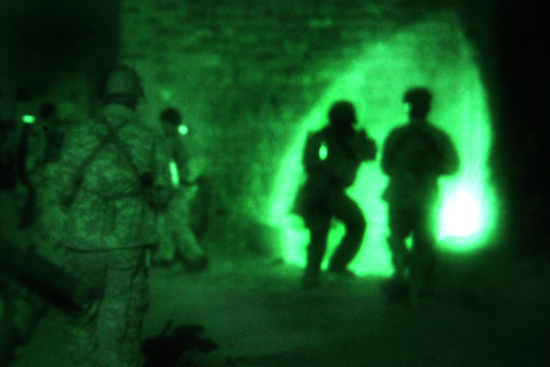|
|
|
As seen through a night-vision device, Coalition forces and Afghan commandos cordon and search a compound during Operation Raven for an improvised explosive device cell operating in the area east of Khost City, Afghanistan, Aug. 31, 2009. US Army photo by Specialist Matthew Freire. |
The Wall Street Journal has a good article on the situation in Afghanistan’s Khost province. This tracks with much of what I’ve heard about the deteriorating security situation in Khost.
On the Haqqani Network’s relationship with Mullah Omar.
An American military official who recently served in eastern Afghanistan said the U.S. had intercepted communications suggesting the Haqqani leadership was closely coordinating its activities in Khost with Mullah Omar, the Taliban’s leader, who is believed to be in Pakistan. “It’s a division of labor, with each group focusing on a different part of Afghanistan,” the official said.
The official said some U.S. intelligence officers suspect that the Haqqani leadership had offered to conquer Khost in exchange for a promise from Mullah Omar that the family would be allowed to rule large swaths of eastern Afghanistan if the armed group eventually retook control of the country.
On the Haqqani Network control in Khost: Both Matt Dupee and I have noted that Khost is central to the Haqqani Network’s power base and that Sabari district is a Haqqani Network stronghold (in fact Matt first reported that the Haqqani Network’s command center is based in Sabari).
Afghan officials said insurgents now control many of the districts surrounding Khost city and use them as launching pads for attacks targeting the city and for campaigns designed to intimidate the local population there.
The district of Sabari, north of the city, has long been an insurgent stronghold, and another neighboring district called Musa Khel has recently fallen to insurgents, according to Afghan government officials.
Likewise, government control of three other nearby districts is limited to the district capitals, while the surrounding areas are in the hands of the insurgents.
“No Afghan security forces or government employees can travel in these areas,” said Hanif Shah Hosseini, a parliamentarian from Khost. “The insurgents have a shadow government in all of these areas.”
And finally, this is what happens when the US’s commitment to the cause wavers. A similar situation occurred in Iraq in 2006, but the US quickly turned it around by showing a commitment and executing the ‘surge.’ This is one of the major reasons why the US’s delaying on making a decision on the path forward is dangerous. And it also provides a cautionary tale of what will happen if the US switches to a counterterrorism-focused mission, which would cede much of the ground to the Taliban.
“At the beginning everyone supported the Americans,” said Mr. Hosseini, the parliamentarian. “But now a lot of locals don’t believe in a U.S. or government victory anymore. They expect the Americans to leave, so they are casting their support to the Taliban.”
Are you a dedicated reader of FDD's Long War Journal? Has our research benefitted you or your team over the years? Support our independent reporting and analysis today by considering a one-time or monthly donation. Thanks for reading! You can make a tax-deductible donation here.








